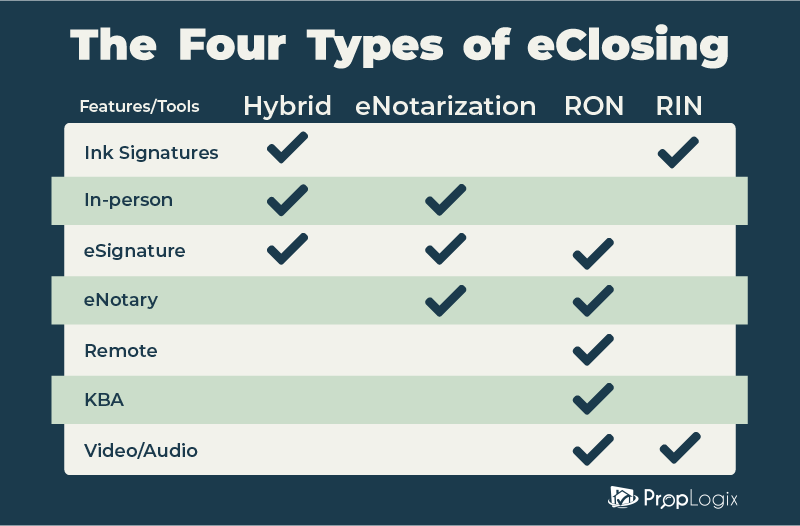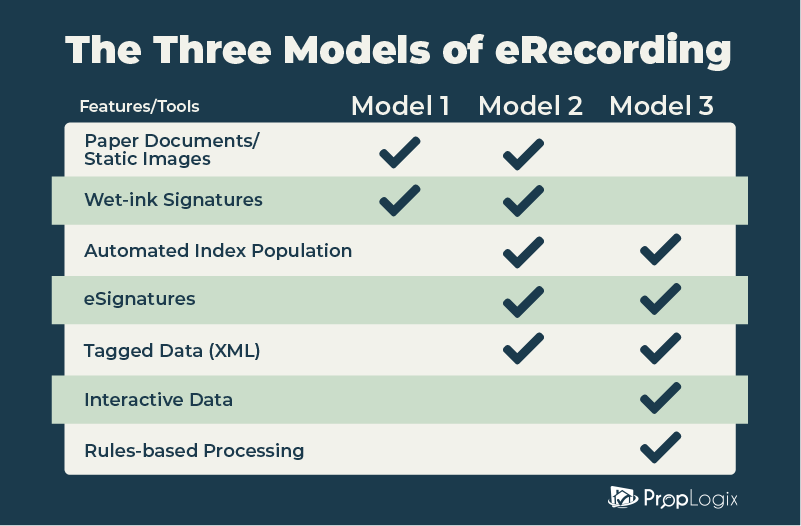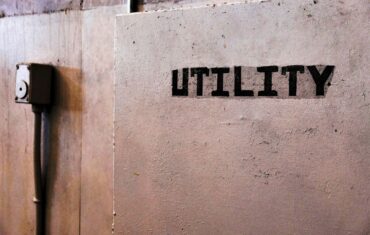According to Simplifile, more than 80% of the United States population lives in a county that participates in eRecording. This means that settlement agents in approximately 2,028 counties can file digital copies of real estate documents and in minutes after a closing, the county recorder can review, record, and return documents to the agent.
In January 2020, Kentucky became the 48th state to authorize eRecording of deeds, mortgages, and other documents, making real estate transactions faster and more cost-effective.
Unfortunately, not nearly as many states have explicitly approved eNotarization and even fewer allow remote online notarization
After eRecording, adoption of eNotarization and remote notarization is the next step in enhancing the real estate closing experience. Here’s how eRecording, eNotarization, and remote notarization work together to better the closing experience.
Different Ways of Using eRecording and eNotarization
Both eRecording and eNotarization are important parts of the eClosing ecosystem. Each is used at different stages in the eClosing process by different participants.
Buyers and sellers along with loan signing agents or notaries and settlement agents are involved in the eNotarization, which is followed by the settlement agent filing the eRecording that’s received, reviewed, and approved according to each specific county recorder’s guidelines.
Hybrid Closings, eNotarization, RON and RIN

eNotarization and remote notarization are often used interchangeably, but they aren’t the same thing. eNotarization involves the application of an electronic notary seal to an eDocument like the deed. Unlike eRecording, eNotarization hasn’t been explicitly approved by as many states and documents that have been notarized using this method are usually permitted only in counties that eRecord under specific regulations or as a result of the Uniform Electronic Transactions Act (UETA).
A hybrid closing involves eSigning closing documents in person. Documents requiring a traditional notary seal or ones that aren’t approved for electronic signatures due to the lender or underwriter’s requests are signed with ink and physically stamped by the notary.
eNotarization is often done in-person at the office of the title company or by a mobile notary that comes to a specified location and meets the signers in person. In this process, the buyer and seller use tablets to eSign and the notary applies their electronic seal.
Even fewer states have approved remote online notarization, which uses eNotarization technology along with audio/visual tools to capture and then store the notarial ceremony. Some of the biggest hurdles to adopting this piece of technology is state approval, insurability, and acceptability by county recorders, lenders, and title insurance underwriters. Additionally, many professionals in real estate are concerned that a signer appearing before a camera instead of in-person doesn’t meet the requirements to affirm their identity.
Others in the title and real estate industry argue that RON tools provide more security than examining government-issued documents like a driver’s license with the naked eye.
Currently only 24 states have approved RON laws to allow fully digital closings while hybrid closings that follow state and local government regulations are legal nationwide.
Since the COVID-19 crisis, states have also temporarily approved the use of audio and video conferencing during the signing and notarization of paper documents. This process has been dubbed a Remote Ink-Signed Notarization(RIN) by Fannie Mae.
Listen to my interview with Danielle Kaiser on digital closings to learn how to introduce more technology into your real estate closings and how RON laws are removing legal and psychological barriers to eClosing.
There are three ways to implement eRecording

PRIA calls these models and defines them in the following ways:
- Model 1 Scanned paper documents with wet signatures with no index data are submitted as images, creating a digitized copy of the paper document.
- Model 2 Scanned paper documents are accompanied by an index data. This is the same as Model 1, but Model 2 includes sending some index information along with the image.
- Model 3 No documents were ever in paper form. Instead, electronic documents or eDocuments with index data embedded into and extractable from the document are submitted for eRecording.
The major differences between the three are whether the document began as a paper or electronic and what technologies are applied to paper documents when digitizing them..
How eNotarization and Remote Online Notarization help fight fraud
While it’s fair to be concerned about the cybersecurity of the vendors who provide these services, the boiler plate built-in features found in most of these tools make manipulation and forgery much more difficult than paper documents.
eNotarization and Remote Online Notarization both help with document and ID fraud respectively. Here’s how:
Secure Collaboration Notaries, title agents, and buyers and sellers create accounts in secure environments where they can send, receive, and review documents before signing, notarizing, and completing the real estate transaction.
Tamper-evident eNotarization tools create a new layer of security by applying a tamper-evident seal to the electronic documents. If the document is altered, the seal is broken and exposes the fraudulent activity.
Metadata For eDocuments, metadata locked in each one provides detailed information about who has accessed eSigned it, eNotarized it (if applicable), and when and where those actions took place.
User Authentication The identity of signers is confirmed by using Knowledge Based Authentication (KBA) questions.
ID Verification A government issued ID, like a driver’s license, is scanned for validity. In one notary challenge, more than 2,900 members of the NNA’s notary community were asked to spot fake IDs. About 32% of the participants failed to find the fake.
Recording of the notarial act Should any part of the notarial act come into question, a recording can be accessed to determine the validity of any claims.
All of the essential elements of the notarial act are executed with eNotarization and Remote Online Notarization tools. With RON there is the additional security of positively identifying a signer with the aid of technology, a recording of the procedure to review, and electronic documents with signatures and stamps corresponding to each act in the recording.
How eRecordings help fight fraud
Since the beginning of the land recording system, there has been fraud. As a result, laws have been developed with the intention of preventing fraud. The requirements of signatures and notary seals have provided some protection, and, of course, title insurance provides an additional layer of protection for lenders and homeowners.
Unfortunately, deed fraud remains an issue in real estate transactions. While there is no tool that can reduce risks of criminal activity to zero, electronic recording provides added technology that enhances the security of real estate transactions.
eRecordings offer more obstacles to successfully recording a fake deed. Here are some examples:
Limited Access Access to the electronic recording system is usually controlled between the county recorder and private third parties like portal software providers and service companies whose success is dependent upon maintaining a secure environment.
Transparency The initial setup for submitting eRecordings requires the submitter to agree to terms with the vendors, set up electronic payments, and install the software. This creates a digital footprint that filters out criminals intending to commit recording fraud.
Encryption Certain protocols and encryption algorithms protect digital documents that paper documents lack.
Audit Trail eRecording creates an audit trail that traces the document from its origins through the recording process and back to the submitter, which is a feature paper documents lack.
PRIA’s eRecording Best Practices promotes eNotarization
In 2015, the Property Records Industry Association (PRIA), a nonprofit organization dedicated to developing and promoting national standards and best practices to protect the integrity of the land records system, released their best practices for eRecording for recorders.
The final of the eleven best practices explicitly endorsed the acceptance of electronically signed and notarized documents by recording jurisdictions.
Other eRecording best practices include:
- Executing Memorandum of Understanding, contracts, or agreements with each eRecording vendor serving that county and not with individual end-user submitters.
- Establishing systems to accept eRecording fees electronically with Automated Clearinghouse (ACH) payments.
- Acceptance of all real estate-related documents for eRecording.
- Creating an internal process for eRecording that’s as simple as paper recording.
- Indexing and recording of the documents is the responsibility of the recorder.
- Standardizing the format of document images with consideration of preservation needs. Scanned documents should be clear and accurately represent the original documents.
- Multiple vendors should be used by the recorder.
- Voiding or removing documents after recording should only be done by court order.
- Submission limitations for each package or batch may be applied by the recorder to no more than 10 documents totaling no more than 200 pages.
- A process to prevent duplicate recordings should be in place.
Vetting eSolution Vendors
The potential security risks associated with moving to fully electronic systems like data corruption, recovery issues, malicious attacks from hackers or even mismanagement from under-trained or disgruntled employees of vendors tend to be overinflated.
The recording of falsified mortgages and deeds via eRecording is far less likely than with the traditional recording process. ID fraud and document fraud is also far less likely to occur during a remote online closing. Unlike paper documents, electronic documents are much less susceptible to fraud and subsequently more secure.
Whether you’re part of a business like a title company or a government employee working in the county recorder’s office, utilizing these eSolutions has a proven track record of fighting fraud.
Introducing any of these digital closing tools into your title company’s operation is a great way to also improve quality control, create opportunities for better customer experiences, and save time during and after a closing.











